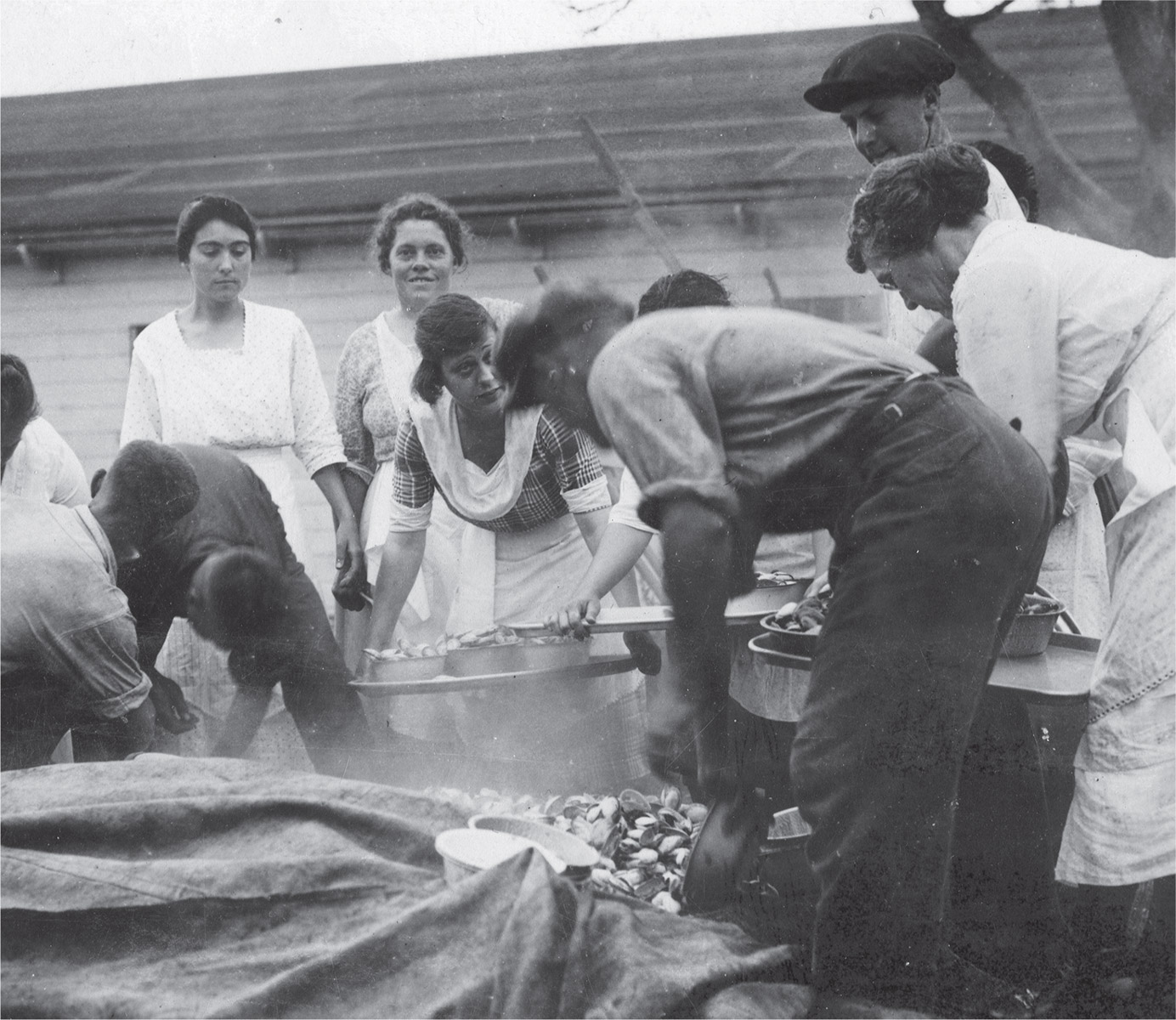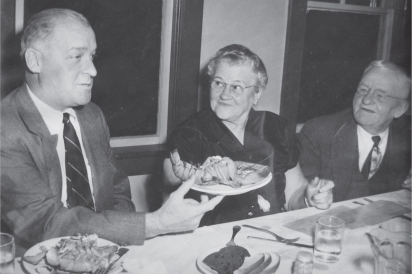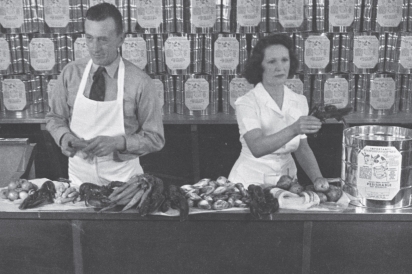Every Picture Tells a Story
Vintage Photos Tell the History of Rhode Island’s Shore Dinner Heritage
From clambakes, fish markets and oyster houses to shore dinner halls, clam shacks and upscale seafood restaurants, Rhode Island’s seafood family tree is both fascinating and delicious to explore. This selection of vintage photos, representing some of its various branches, is just part of the collection amassed in our 2017 book Rhode Island Clam Shacks, from Arcadia Publishing. Stories of success, loss and rebirth are all part of the canon that originated with the clambake.
Clambakes
The story of Johnson’s Hummocks started with a clambake in North Kingstown and ended as a huge restaurant in Providence. For a good part of the last century, there was no name more associated with a good clam dinner in Rhode Island than Johnson (and for those of you of a certain age, we don’t mean Howard).
In 1905, Frank Johnson built the first permanent structure of a clambake facility he called the Hummocks on a sandy peninsula in the village of Hamilton just outside of Wickford. At first, there was just a roof resting on cedar posts covering long benches set on the bare ground, but by 1910 this had evolved into a hall with the capacity to seat 1,400 diners. The Johnsons didn’t have the best of luck, and in 1925 a cigarette ignited a fire that destroyed everything except the Johnson family homestead.
Frank’s son Henry rebuilt. Then the hurricane of 1938 caused another total loss, and a new pavilion built after that lost its roof in another hurricane in 1944.
Deciding that the bucolic peninsula where so many had enjoyed clambakes, followed by ball games, band concerts and swimming, was too vulnerable to the elements, Henry built a solid brick restaurant at 245 Allens Avenue in Providence boasting a “Lobster Room,” with lobsters fresh from Johnson’s saltwater purifying tanks in Wickford. Johnson’s Hummocks Grille never forgot its clambake origins (it even published a history called It Started With a Clambake!) and its menus stated on the cover, “Under the same management as the OLD HUMMOCKS at Hamilton Rhode Island.” Johnson’s Hummocks Grille closed its doors on May 19, 1970.
Shore Dinner Halls
Clambake pavilions and shore dinner halls often sprouted in places where regular outdoor clambakes were held. A shore dinner hall was a must-have for any self-respecting shore resort. By the late 1800s, multiple steamers and trolley lines brought patrons to and from an array of resorts around Narragansett Bay, including Hunt’s Mills, Kettle Point, Squantum Point, Ocean Cottage, Silver Spring, Cedar Grove, Camp White, Crescent Park, Portsmouth Grove and Sakonnet Point on the east shore, and Field’s Point, Rocky Point, Oakland Beach and Buttonwoods on the west.
Located a little south of Squantum Point in East Providence, Silver Spring was opened around 1863 by Hiram D. Maxwell to compete with the clam bake pavilion at Field’s Point across the bay. Silver Spring had its own steamship landing and bakery, and its dining hall, located on the rocky shore, could comfortably accommodate 600 people for shore dinners in a season that ran from June 1 to September 20.
A June 13, 1883, blurb in the Evening Bulletin noted, “A large number availed themselves of the opening of the season and the consequent shore dinner at Silver Spring to-day. Every seat in the main dining hall was filled, and the dinner itself was excellent, including the succulent clam, baked and in chowder, blue fish, lobster, clam cakes, etc. etc. ... It is a notable fact that Silver Spring clams are free from grit, by no means a small consideration to clam-eaters who have sensitive teeth.”
Aunt Carrie’s
As the supremacy of the huge shore dinner halls declined in the early 20th century, the age of the clam shack was just beginning.
They say all politics is local, and delving into the nearly 100-year-history of Aunt Carrie’s in Point Judith, things get surprisingly political. In 1920, Carrie and her husband Ulysses “Uncle Lys” Grant Cooper opened a small shack near the Point Judith lighthouse serving lemonade and clam fritters (yes, they called them clam fritters and not clam cakes).
Not only was Uncle Lys busy preparing clambakes, served on the beach at the Coopers’ campground and at the Kingston Fair Grounds, but in 1938 he was elected on the Republican ticket to the Rhode Island General Assembly. Each year, the couple hosted all the members of the House to a clambake at Aunt Carrie’s—and on that day there were no Republicans or Democrats, just friends of Uncle Lys and Aunt Carrie. The Rhode Island clam shack icon, which moved to its current location in 1925, is still known to this day as Aunt Carrie’s.
Clam Shacks
For every 100-year success story like Aunt Carrie’s, there are scores of clam shacks that succumbed to changing trends, competition, bad management, bad luck or generational apathy.
Dave’s Seafood Restaurant in Portsmouth was one that only lasted a few years. Located adjacent to the Stone Bridge on Park Avenue in Island Park, it was run by World War I veteran David E. Lemay and his wife, Ida.
Portsmouth resident Jack Plourde was a paperboy in the mid-’50s and remembers the place as “a real greasy spoon with health code issues.” In December 1953, the owners were charged “with possessing and serving oleomargarine without clearly designating it as such,” a charge they denied.
The business seemingly survived hurricanes Carol and Edna in 1954 but when Stone Bridge was closed permanently in 1956, cutting them off from their Tiverton customers, it must have hit the Lemays’ bottom line pretty hard. By 1958, according to the Fall River Directory, they had relocated to that city.
Other Fishy Concerns
On one of the family tree’s stubby side branches is the curiosity known as the prepackaged clambake. This postcard advertises “The Original Wickford Clambake,” an innovative product of Wickford Shellfish, a popular fish market. The nifty tins, filled with all the fixings for a clambake, could be taken home and cooked over an open fire, in a fireplace or on a kitchen range in just an hour. One simply added water to the contents of lobster, clams, fish, sausage and potatoes and brought the contents to a boil.
The traditionalist will point out that this is not really a clambake. There are no heated stones or rockweed involved. Such “take home” clambakes were a fad in the 1950s and ’60s, revealing a yearning for a once-ubiquitous summer ceremony—the clambake—that had nearly disappeared from Rhode Island’s shores.
They are co-authors of Rhode Island Clam Shacks from Arcadia Publishing (April 2017).









